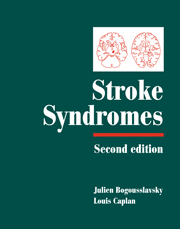Book contents
- Frontmatter
- Contents
- List of contributors
- Preface
- PART I CLINICAL MANIFESTATIONS
- PART II VASCULAR TOPOGRAPHIC SYNDROMES
- 29 Arterial territories of human brain
- 30 Superficial middle cerebral artery syndromes
- 31 Lenticulostriate arteries
- 32 Anterior cerebral artery
- 33 Anterior choroidal artery territory infarcts
- 34 Thalamic infarcts and hemorrhages
- 35 Caudate infarcts and hemorrhages
- 36 Posterior cerebral artery
- 37 Large and panhemispheric infarcts
- 38 Multiple, multilevel and bihemispheric infarcts
- 39 Midbrain infarcts
- 40 Pontine infarcts and hemorrhages
- 41 Medullary infarcts and hemorrhages
- 42 Cerebellar stroke syndromes
- 43 Extended infarcts in the posterior circulation (brainstem/cerebellum)
- 44 Border zone infarcts
- 45 Classical lacunar syndromes
- 46 Putaminal hemorrhages
- 47 Lobar hemorrhages
- 48 Intraventricular hemorrhages
- 49 Subarachnoid hemorrhage syndromes
- 50 Brain venous thrombosis syndromes
- 51 Carotid occlusion syndromes
- 52 Cervical artery dissection syndromes
- 53 Syndromes related to large artery thromboembolism within the vertebrobasilar system
- 54 Spinal stroke syndromes
- Index
- Plate section
48 - Intraventricular hemorrhages
from PART II - VASCULAR TOPOGRAPHIC SYNDROMES
Published online by Cambridge University Press: 17 May 2010
- Frontmatter
- Contents
- List of contributors
- Preface
- PART I CLINICAL MANIFESTATIONS
- PART II VASCULAR TOPOGRAPHIC SYNDROMES
- 29 Arterial territories of human brain
- 30 Superficial middle cerebral artery syndromes
- 31 Lenticulostriate arteries
- 32 Anterior cerebral artery
- 33 Anterior choroidal artery territory infarcts
- 34 Thalamic infarcts and hemorrhages
- 35 Caudate infarcts and hemorrhages
- 36 Posterior cerebral artery
- 37 Large and panhemispheric infarcts
- 38 Multiple, multilevel and bihemispheric infarcts
- 39 Midbrain infarcts
- 40 Pontine infarcts and hemorrhages
- 41 Medullary infarcts and hemorrhages
- 42 Cerebellar stroke syndromes
- 43 Extended infarcts in the posterior circulation (brainstem/cerebellum)
- 44 Border zone infarcts
- 45 Classical lacunar syndromes
- 46 Putaminal hemorrhages
- 47 Lobar hemorrhages
- 48 Intraventricular hemorrhages
- 49 Subarachnoid hemorrhage syndromes
- 50 Brain venous thrombosis syndromes
- 51 Carotid occlusion syndromes
- 52 Cervical artery dissection syndromes
- 53 Syndromes related to large artery thromboembolism within the vertebrobasilar system
- 54 Spinal stroke syndromes
- Index
- Plate section
Summary
Introduction
Intraventricular hemorrhage (IVH) can occur following rupture of parenchymal hemorrhage into the ventricular system (secondary IVH) or can result from disease processes either within the ventricular system or just beneath the ventricular wall (primary IVH). This chapter will concentrate on primary IVH and briefly discuss secondary IVH. IVH during the neonatal period and IVH in the presence of generalized subarachnoid hemorrhage are not discussed.
In 1881, following a review of 94 cases, Sanders (1881) coined the term primary intraventricular hemorrhage. He described the clinical syndrome as occurring in the very young and the very old. It was of rapid onset, with profound coma from the outset, with convulsions (though paralysis frequently was absent), rapidly leading to death. He further added that ‘most authors agree with the statement that extravasation of the blood into the ventricles is uniformly and rapidly fatal’. Such pessimistic views continued for half a century (Gordon, 1916). It is not surprising that such a view was common, because those earlier observations had been based on postmortem studies. Subsequent to the introduction of computed tomography (CT), non-fatal IVH has been recognized (Butler et al., 1972; De Weerd, 1979; Gates et al., 1986).
Neuroanatomic considerations
In the circulation in the subependymal or periventricular region, there is a distinct periventricular centrifugal supply of blood, with the direction of flow being from the ventricular surface toward the parenchyma for a distance of up to 1.5 cm. The periventricular arteries originate beneath the ependyma as terminal branches of the anterior and posterior choroidal arteries and of some of the striatal rami of the middle cerebral artery.
- Type
- Chapter
- Information
- Stroke Syndromes , pp. 612 - 617Publisher: Cambridge University PressPrint publication year: 2001



